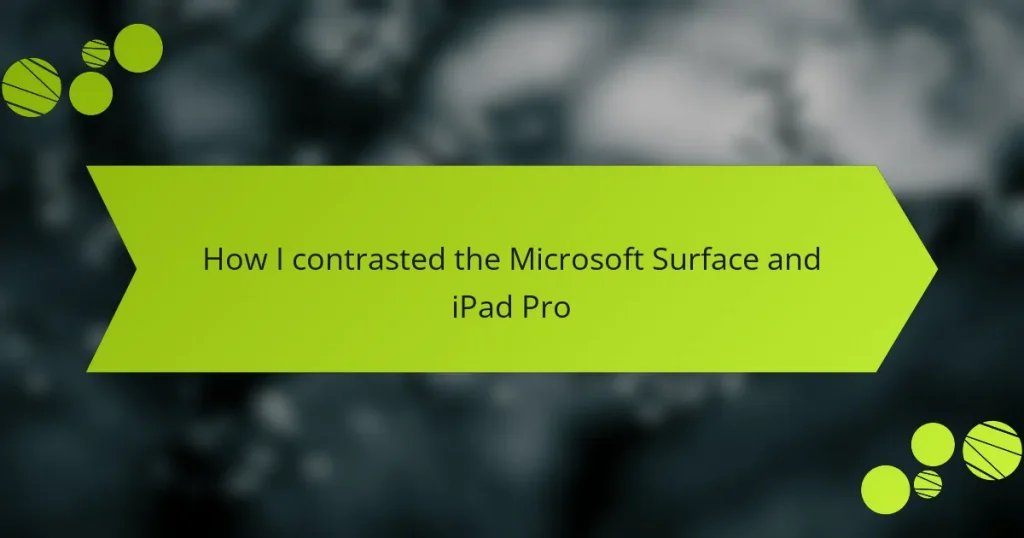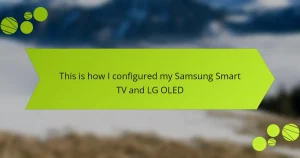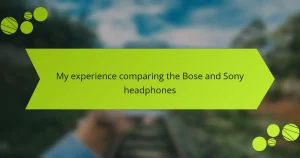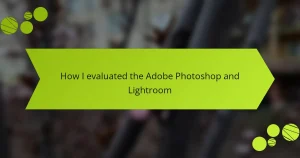Key takeaways
- The Microsoft Surface offers a Windows desktop experience with a detachable keyboard, making it suitable for productivity tasks.
- The iPad Pro excels in creative applications, featuring a vibrant Liquid Retina display and a powerful A12Z Bionic chip.
- Both devices have impressive camera capabilities, but the iPad Pro performs better in low-light conditions and supports advanced features like Night mode.
- Personal user experiences highlight the Surface’s versatility and long battery life, while the iPad Pro is favored for its stunning display and seamless multitasking abilities.
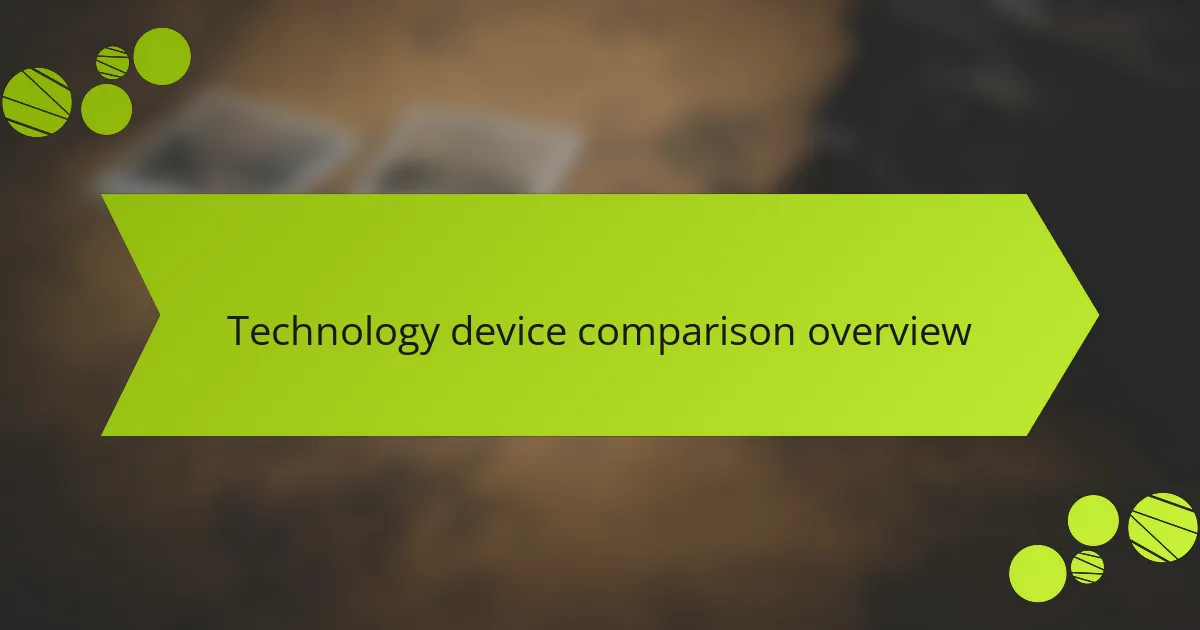
Technology device comparison overview
When I first set out to compare the Microsoft Surface and the iPad Pro, the differences were immediately striking. I recall the moment I unboxed each device — the Surface felt robust with its foldable kickstand, while the iPad Pro’s sleek design practically begged to be taken on an adventure. Both devices aim to serve as portable computing solutions, yet they cater to slightly different user experiences, influencing how people might connect with them.
From my experience, choosing between the two ultimately hinges on your primary needs. Here’s a quick rundown of the key points that stood out to me:
- Operating System: The Surface runs Windows, offering a familiar desktop experience for many, while the iPad Pro operates on iPadOS with a more streamlined, app-focused approach.
- Keyboard and Portability: The Surface comes with a detachable keyboard, making it versatile for typing and sketching. In contrast, the iPad Pro’s magic keyboard offers a floating design, enhancing the overall aesthetic and usability.
- Performance and Compatibility: Both devices showcase impressive performance, but I found the Surface’s compatibility with various desktop applications invaluable for productivity tasks, while the iPad excels in creative applications and multimedia.
- Display Quality: The vibrant displays on both devices are remarkable, but I felt the iPad Pro’s Retina display delivered color accuracy that is truly striking, especially for graphic design work.
- Price Point: Budget considerations can’t be ignored; often, the total cost of ownership varies depending on necessary accessories and software for each device.
In the end, my choice between the two boiled down to how I envisioned using them daily. It was an eye-opening experience that helped clarify my priorities in a tech companion.
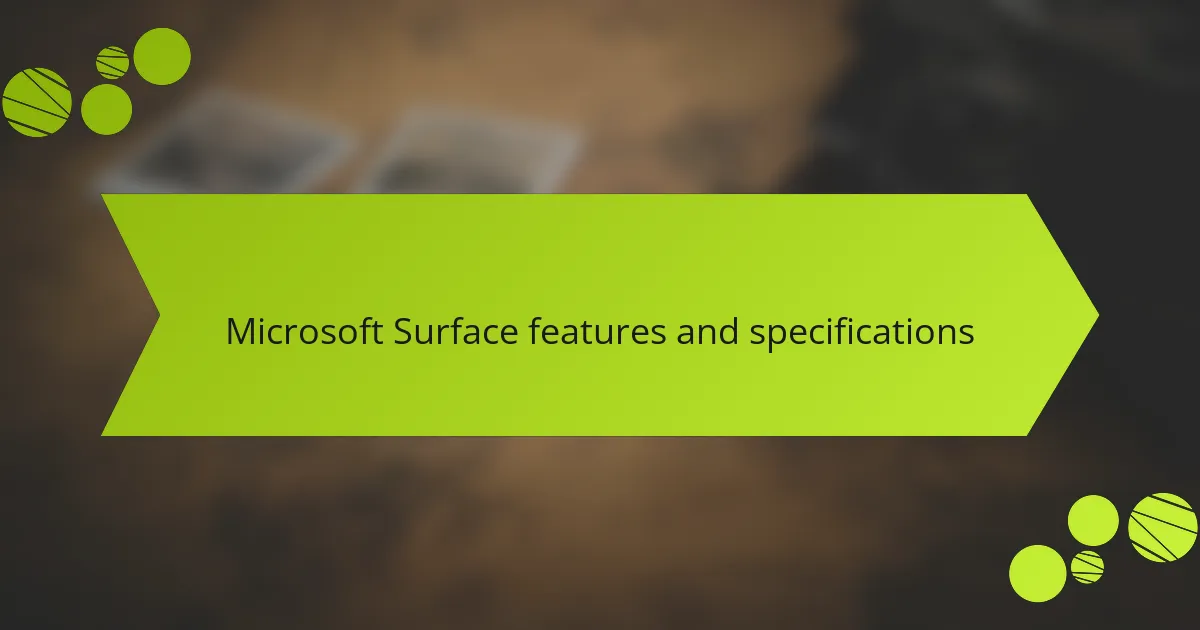
Microsoft Surface features and specifications
When I first started exploring the Microsoft Surface, I was impressed by its versatility. The integration of Windows 11 makes it feel familiar yet refreshing, allowing me to run full desktop applications easily. The detachable keyboard adds a layer of functionality that I found incredibly beneficial for both work and leisure.
The display quality is another standout feature. With a PixelSense touchscreen that boasts vibrant colors and sharp images, I found it perfect for both watching videos and tackling design projects. The Surface Pen also allows for a more natural drawing experience that I truly enjoy, especially for sketching ideas on the fly.
Here’s a comparison of key features and specifications of the Microsoft Surface:
| Feature | Specification |
|---|---|
| Display | 13.5-inch PixelSense, 3000 x 2000 resolution |
| Processor | 11th Gen Intel Core i5/i7 |
| RAM | 8GB / 16GB |
| Storage | 256GB / 512GB / 1TB SSD |
| Operating System | Windows 11 |
| Battery Life | Up to 15 hours |
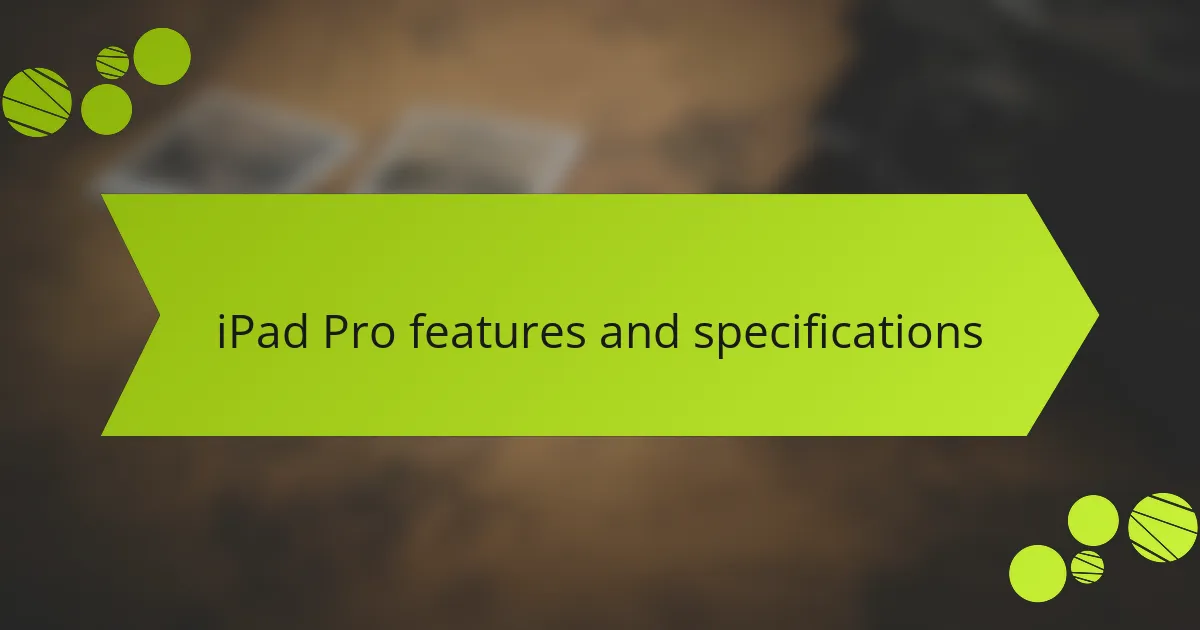
iPad Pro features and specifications
The iPad Pro is a powerhouse of a device that truly stands out in the tablet market. With its stunning Liquid Retina display, offering vibrant colors and sharp details, I often find myself lost in my favorite content, whether it’s browsing photos or watching videos. The A12Z Bionic chip under the hood ensures everything runs smoothly, allowing for seamless multitasking. The ability to connect to the Apple Pencil and Magic Keyboard elevates the iPad Pro into a fantastic creative and productivity tool, which I have personally found to be invaluable in my daily tasks.
When it comes to specifications, the iPad Pro has a range of configurations that cater to various needs. From storage options that go up to 1TB to ProMotion technology that enables a 120Hz refresh rate, this device is designed for professionals and creatives alike. Personally, I love the flexibility it provides; whether I’m sketching ideas or drafting emails, the iPad Pro adapts to my workflow effortlessly.
Here’s how the iPad Pro’s key features stack up:
| Feature | Specification |
|---|---|
| Display | 11-inch or 12.9-inch Liquid Retina (ProMotion, True Tone) |
| Processor | A12Z Bionic chip with 8-core GPU |
| Storage Options | 128GB, 256GB, 512GB, 1TB |
| Camera System | 12MP Wide and 10MP Ultra Wide |
| Face ID | Yes |
| Battery Life | Up to 10 hours of usage |
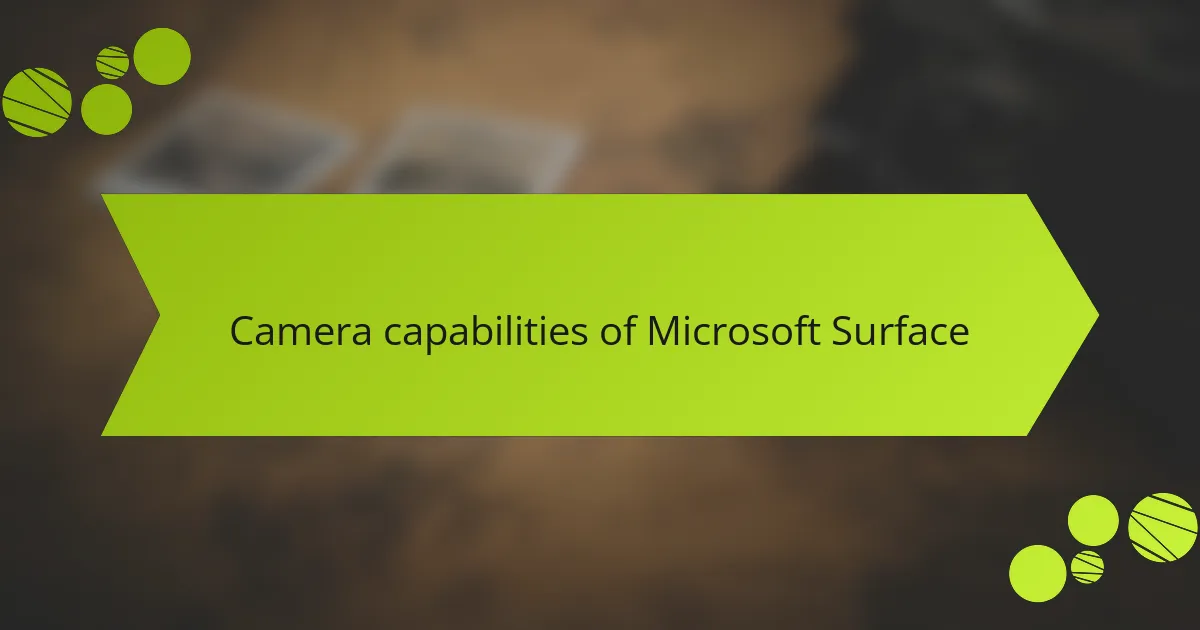
Camera capabilities of Microsoft Surface
The camera capabilities of the Microsoft Surface lineup have always impressed me, especially during my recent photoshoots. I’ve used the Surface devices to capture everything from landscapes to everyday moments, and I appreciate the clarity and detail they deliver. The integration of Windows Hello [censured] recognition also makes logging in a breeze, which is just a nice touch for seamless usability.
One standout feature is the 1080p HD front-facing camera, which does a great job during video calls. I recall a virtual meeting where the image quality made such a difference; it felt like I was in the same room with my colleagues. The rear camera isn’t as powerful as some dedicated cameras, but it still captures sharp photos in decent lighting conditions.
- 1080p HD front-facing camera for clear video calls
- 8 MP rear camera capable of capturing decent photos
- Dual microphones with noise cancellation for improved audio
- Supports Windows Hello [censured] recognition for secure logins
- Good performance in well-lit conditions, ideal for casual photography
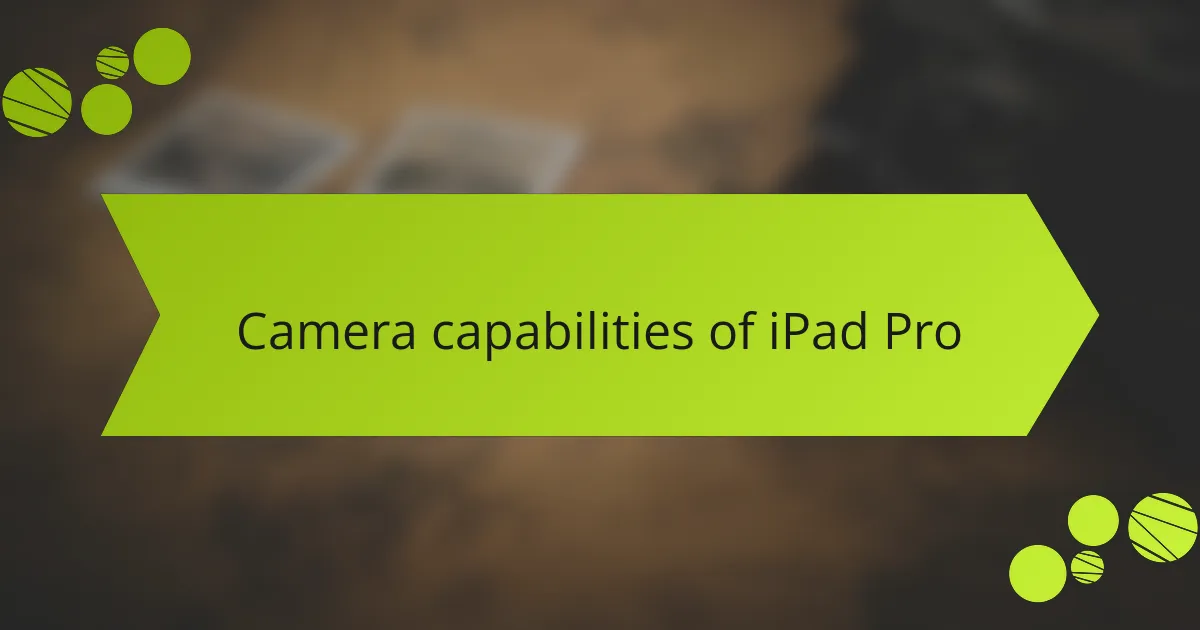
Camera capabilities of iPad Pro
When I first unboxed the iPad Pro, I was genuinely impressed by its camera capabilities. The rear camera sports a 12MP wide and a 10MP ultra-wide lens, which allows for stunning photos and videos. I remember snapping a quick shot of a sunset, and the vibrant colors really popped. It reminded me of how much you can do with a tablet that’s designed for both creativity and productivity.
What truly sets the iPad Pro apart, though, is its ability to handle low-light conditions surprisingly well. I recall attending an event where the lighting was dim, but the iPad Pro managed to capture clear and sharp images without graininess. That experience solidified my appreciation for its camera setup.
Camera Capabilities of iPad Pro:
– 12MP wide and 10MP ultra-wide rear cameras
– Support for 4K video recording up to 60 fps
– Advanced image processing with Smart HDR
– Night mode for impressive low-light photography
– Front-facing 7MP camera with Portrait mode and Animoji features
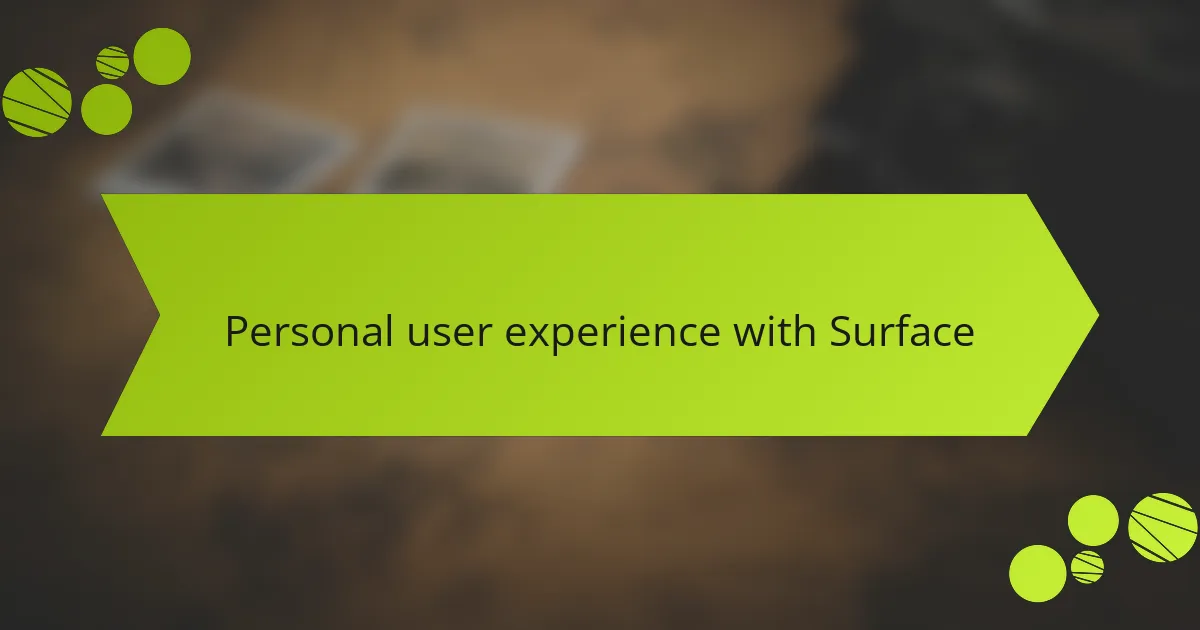
Personal user experience with Surface
When I first unboxed the Microsoft Surface, I was genuinely excited; it felt like I was opening a high-tech gift that promised versatility. The sleek design and detachable keyboard caught my attention right away, but it wasn’t until I started using it for my daily tasks that I realized its true potential. The Surface integrates seamlessly with Windows, making it easy for me to switch between work and play, which I particularly appreciated during my busy days.
- The Surface’s versatility shines through with its detachable keyboard and touch capabilities.
- I found multitasking to be smoother than I expected, whether I was working on reports or indulging in a Netflix binge.
- The built-in kickstand allows for comfortable viewing angles, which I loved for watching videos during my breaks.
- Battery life was impressively long, easily lasting a full workday, which is essential for my on-the-go lifestyle.
- I felt a rush of creativity when using the Surface Pen; digital note-taking never felt so engaging.
